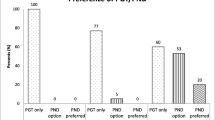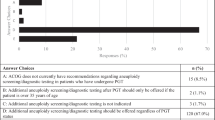Abstract
Members of families affected by hereditary cancer are often concerned about passing on risk to offspring. Preimplantation genetic diagnosis is a procedure performed to identify embryos that inherit mutations placing them at risk for hereditary conditions. Little is known about attitudes toward the use of this technology among individuals at risk for hereditary breast and ovarian cancer. We sought to determine high risk women’s attitudes. This study is a qualitative examination of comments from women who participated in an online survey regarding knowledge and attitudes of preimplantation genetic diagnosis among individuals affected by hereditary breast and ovarian cancer. More than half the respondents held less favorable attitudes about the use of preimplantation genetic diagnosis for hereditary breast and ovarian cancer for both themselves and others. However, among the women who felt favorable about its usage, the majority said it became a new option for them to pursue parenthood whereas previously they had opted to not have a biological child. The high percentage of respondents who have never heard of preimplantation genetic diagnosis and who were in favor of this technology for hereditary breast and ovarian cancer indicates the need for educational campaigns to increase awareness and provide information about the procedure, access and affordability. Further research is needed to determine how this population would like this information presented to them and how best to instruct health care professionals to present this topic to women who do not know to ask about it.
Similar content being viewed by others
Abbreviations
- BRCA1/2 :
-
Breast cancer 1 and 2 genes
- HBOC:
-
Hereditary breast and ovarian cancer
- PGD:
-
Preimplantation genetic diagnosis
- IVF:
-
In vitro fertilization
- CVS:
-
Chorionic villous sampling
- FISH:
-
Fluorescence in situ hybridization
- FAPC:
-
Familial adenomatous polyposis coli
- HFEA:
-
Human fertilization and embryology authority
- FORCE:
-
Facing our risk of cancer empowered
References
Miki Y, Swensen J, Shattuck-Eidens D et al (1994) A strong candidate for the breast and ovarian cancer susceptibility gene BRCA1. Science 266(5182):66–71. doi:10.1126/science.7545954
Wooster R, Bignell G, Lancaster J et al (1995) Identification of the breast cancer susceptibility gene BRCA2. Nature 378(6559):789–792. doi:10.1038/378789a0
HFEA Choices and Boundaries Report (2006) [cited Sept 15, 2007]; Available from: http://www.hfea.gov.uk/docs/Choices_and_boundaries_Report_2006.pdf
Menon U, Harper J, Sharma A, Fraser L, Burnell M, ElMasry K, Rodeck C, Jacobs I (2007) Views of BRCA gene mutation carriers on preimplantation genetic diagnosis as a reproductive option for hereditary breast and ovarian cancer. Hum Reprod 22(6):1573–1577. doi:10.1093/humrep/dem055
Weitzel J, McCaffrey S, Nedelcu R, MacDonald D, Blazer K, Cullinane C (2003) Effect of genetic cancer risk assessment on surgical decisions at breast cancer diagnosis. Arch Surg 138:1323–1328. doi:10.1001/archsurg.138.12.1323
Friedman LC, Kramer RM (2005) Reproductive issues for women with BRCA mutations. J Natl Cancer Inst Monogr 34:83–86. doi:10.1093/jncimonographs/lgi012
Staton AD, Kurian AW, Cobb K, Mills MA, Ford JM (2007) Cancer risk reduction and reproductive concerns in female BRCA1/2 mutation carriers. Fam Cancer 7:179–186
Quinn G, Vadaparampil S, Wilson C et al (2009) Attitudes of high-risk women toward preimplantation genetic diagnosis. Fertil Steril 91:2361–2368
Miki Y, Swensen J, Shattuck-Eidens D et al (1994) A strong candidate for the breast and ovarian cancer susceptibility gene BRCA1. Science 266:66–71. doi:10.1126/science.7545954
Ogilvie C, Braude P, Scriven P (2005) Preimplantation genetic diagnosis- an overview. J Histochem Cytochem 53:255–260. doi:10.1369/jhc.4B6395.2005
Lancaster JM, Wiseman RW, Berchuck A (1995) An inevitable dilemma: prenatal testing mutations in the BRCA1 breast-ovarian cancer susceptibility gene. Obstet Gynecol 87:306–309
Smith KR, Ellington L, Chan AY, Croyle RT, Botkin JR (2004) Fertility intentions following testing for a BRCA1 gene mutation. Cancer Epidemiol Biomarkers Prev 13(5):733–740
Ao A, Wells D, Handyside AJ, Winston RML, Delhanty JDA (1998) Preimplantation genetic diagnosis of inherited cancer: familial adenomatous polyposis coli. Genetics 15(3):140–144
Paek B (2003) Prenatal diagnosis. World J Surg 27(1):27–37. doi:10.1007/s00268-002-6734-5
Handyside AH, Kontogianni EH, Hardy K, Winston RML (1990) Pregnancies from biopsied human preimplantation embryos sexed by Y-specific DNA amplification. Nature 344:768–770
Marik JJ Preimplantation Genetic Diagnosis. E-Medicine (2005) [cited Nov 26, 2007]; Available from: http://www.emedicine.com/med/topic3520.htm#section~bibliography
Verlinsky Y, Ginsburg N, Lifchez A, Valle J, Moise J, Strom C (1990) Analysis of the first polar body: preconception genetic diagnosis. Hum Reprod 5:826–829
Zitner A (2002) The nation: cloning receives a makeover politics: nuances of language helped reframe the debate and derail an all-out ban in congress. LA Times, p A1
Offit K, Sagi M, Hurley K (2006) Preimplantation genetic diagnosis for cancer syndromes. JAMA 296:2727–2730. doi:10.1001/jama.296.22.2727
Testart J, Sele B (1995) Towards an efficient medical eugenics: is the desirable always the feasible? Hum Reprod 10(12):3086–3090
(2006) Editorial, the leading edge. Ethics of preimplantation genetic diagnosis for cancer. Lancet Oncol 7(8):611. doi:10.1016/S1470-2045(06)70768-9
Simpson JL (2001) Celebrating preimplantation genetic diagnosis of p53 mutations in Li-Fraumeni syndrome. Reprod Biomed Online 3:2–3
Hudson K (2002) Public awareness and attitudes about reproductive genetic technology. Genetics and Public Policy Center, Washington, DC
Hudson KL (2006) Preimplantation genetic diagnosis: public policy and public attitudes. Fertil Steril 85:1638–1645. doi:10.1016/j.fertnstert.2006.01.014
Woodsong C, Severy LJ (2005) Generation of knowledge for reproductive health technologies: constraints on social and behavioral research. J Soc Issues 61(1):193–205. doi:10.1111/j.0022-4537.2005.00401.x
Braude P (2006) Preimplantation diagnosis for genetic susceptibility. N Engl J Med 355:541–543. doi:10.1056/NEJMp068139
Guba EG (1978) Toward a methodology of naturalistic inquiry in educational evaluation. University of California, Los Angeles
Patton MQ (2002) Qualitative research and evaluation methods. Thousand Oaks, Sage Publications
Dye JF, Schatz IM, Rosenberg BA, Coleman ST (2000) Constant comparison method: a kaleidoscope of data. Qual Rep 4:1–2
Shahine LK, Kuppermann M, Davis G, Creasman J, Cedars MI (2008) Patient willingness to participate in a clinical trial with preimplantation genetic diagnosis. Fertil Steril 89(4):879–884
Kalfoglou AL, Doksum T et al (2005) Opinions about new reproductive genetic technologies. Fertil Steril 83:1612–1621. doi:10.1016/j.fertnstert.2005.01.090
Kalfoglou AL, Scott J, Hudson K (2005) PGD patients’ and providers’ attitudes to the use and regulation of preimplantation genetic diagnosis. Reprod Biomed Online 11:486–496
Greendale K, Pyeritz RE (2001) Empowering primary care health professionals in medical genetics: How soon? How fast? How far? Am J Med Genet C Semin Med Genet 106(3):223–232. doi:10.1002/ajmg.10010
Olsen S (2002) Cancer genetics: information source for patients and families. Cancer Pract 2:323–326. doi:10.1046/j.1523-5394.2002.106004.x
Wonderlick AL, Fine BA (1997) Knowledge of breast cancer genetics among breast cancer patients and first-degree relatives of affected individuals. J Genet Couns 6(2):111–130
Donelle L, Loffman-Goetz L, Clarke JN (2004) Portrayal of genetic risk for breast cancer. Women Health 49(4):93–111
Acknowledgments
This work is supported in part by the American Cancer Society, Atlanta, GA, RSGPB-07-019-01-CPPB. The work contained within this publication was supported in part by the Survey Methods Core Facility at the Moffitt Cancer Center.
Author information
Authors and Affiliations
Corresponding author
Rights and permissions
About this article
Cite this article
Quinn, G.P., Vadaparampil, S.T., King, L.M. et al. Conflict between values and technology: perceptions of preimplantation genetic diagnosis among women at increased risk for hereditary breast and ovarian cancer. Familial Cancer 8, 441–449 (2009). https://doi.org/10.1007/s10689-009-9263-7
Received:
Accepted:
Published:
Issue Date:
DOI: https://doi.org/10.1007/s10689-009-9263-7




